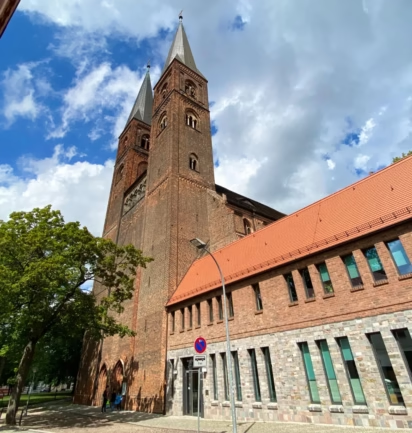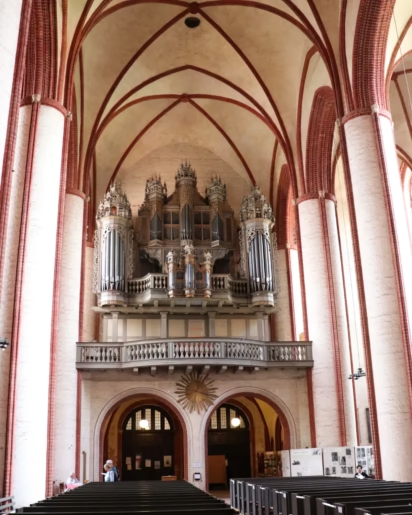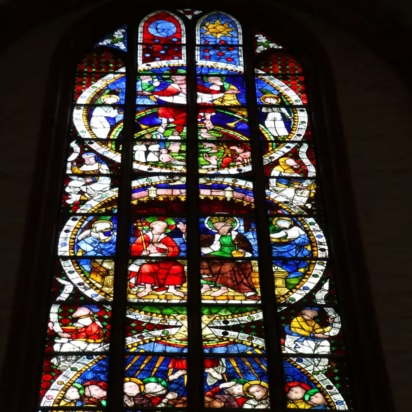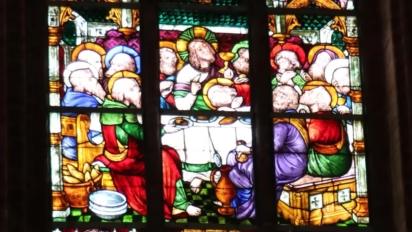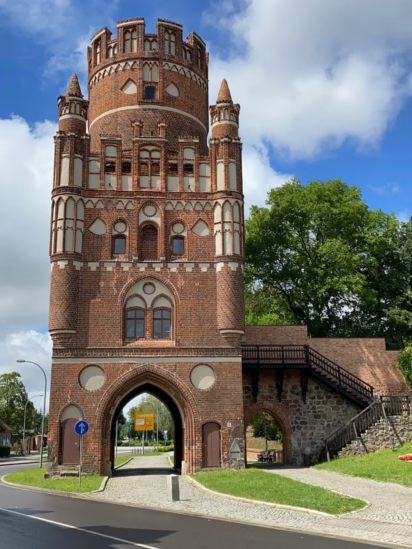Visit the Dom St Nikolaus (St Nicholas) in Stendal, Saxony-Anhalt, to see one of the largest ensembles of medieval stained-glass windows in Germany.

The brick-gothic Dom St Nikolaus (Cathedral of St Nicolas) in Stendal is famous for its large collection of 15th-century stained-glass windows. Although never actually a cathedral, it was a collegiate church before the Reformation, it is the largest church in the Altmark region of Saxony-Anhalt, Germany. The westwork and towers are mostly Romanesque but the rest of this large triple-nave hall church with choir is brick gothic from the mid-15th century. Most of the church survived a direct hit at the end of the Second World War, as did the valuable stained-glass windows that were already in safe storage. The church is usually only open to visitors during the summer months.
Dom St Nikolaus (Cathedral of St Nicolas) in Stendal

The Dom St Nikolaus (Cathedral of St Nicolas) in Stendal was founded in 1188, as a collegiate church by no lesser persons than the Margrave of Brandenburg, the Ascanian Otto II, and his brother, Count Heinrich von Gardelegen. They probably had bigger plans for this complex but Heinrich died soon after and Stendal never became a Domkapitel (cathedral chapter).
However, they succeeded in obtaining papal privileges with Stendal directly under papal rule and not any local archbishopric. As a result, it was in seniority in the margraviate only behind Brandenburg and Havelberg.
The Dom St Nikolaus was never a cathedral in the sense of a bishop’s seat and this was never the intention either. Officially it was a Kollegiatstift (collegiate church). The name “Dom” came from local habit as the church was the largest and most important in the region.
The reformation was introduced in Stendal in 1539 and the collegiate church finally disbanded in 1551. Such a large church was hard to maintain as a simple parish church and was reportedly in a dilapidated state during the 18th and 19th centuries. However, following its 700th year anniversary, a major restoration project saved the church, cloisters, and windows. Much of its current appearance is due to that restoration project.
A direct hit during a bombing raid on 8 April 1945 damaged the western cloisters and the southern transept. It also blew out the few remaining windows — the best stained glass was already in safe storage for years. The church was repaired soon after but the cloisters were only restored in 2013 using a modern glass wall.
Construction of St Nicholas in Stendal
Construction of the first Romanesque collegiate church of St Nicolas in Stendal started in 1188 and was heavily influenced by the large Premonstratensian collegiate church in nearby Jerichow. Of this Romanesque basilica, only the lower parts of the westwork, towers, and a few minor items inside the church survived.
Most of the current late Gothic brick church is from the mid-15th century, built between 1423 and 1463. This church is a triple-nave hall church with a protruding transept and a large choir.
The original westwork was kept, as may easily be seen from the outside, where the new hall church is slightly wider. An extra story was added to the towers in the 15th century to make them more in keeping with the new larger church. Although the portals were changed to Gothic arches, Romanesque details are still clearly visible on the outside of the towers.
An architectural highlight of the exterior is the stepped gable of the northern transept. It is one of the highlights of European brick Gothic architecture and is probably by Steffen Boxthude, to who the Uenglinger Tor town gate in Stendal is also attributed. This was the original main entrance and is flanked by sandstone statues from 1370/80 of the two patron saints of the church: St Nicholas and St Bartholomew.
This northern entrance famously has two stars of David, which have been debated much in later centuries. The legend that a rich local Jewish merchant funded much of the church has been disproved. Current thinking is that the star of David was not particularly seen as a Jewish emblem in the Middle Ages in this region and was more likely considered an apotropaic magical symbol (by both Christians and Jews) to ward off evil.
Interior of St Nicholas
Inside, the triple-naves of the hall church have typical gothic vaulting reaching up to 22 m in the central nave and 25 m at the crossing. The sides of the naves originally had around 30 private family altars but these were removed and the walls are now mostly decorated with epitaphs and gravestones — some are of high artistic quality.
Prior to the Reformation, the church had 35 Vikare (priests / vicars) who did daily prayers at the altars and chapels.
The stylish, simple wooden late-baroque chancel was made 1744 on the orders of Prussian King Friedrich II (Frederik the Great), who considered the previous Renaissance one unsuitable for the main church in his garrison town. The dove above is probably from the original soundboard, which was lost.
The first organ was in a swallow nest high up the wall of the northern nave. The current organ, positioned more conventionally above the western entrance, is a modern instrument created between 1954 and 1970 by Alexander Schuke in a baroque casing from 1671. It is with three manuals and pedals, 56 stops, and 4343 pipes, the largest organ in the Altmarkt region. Concerts are frequently held in summer.
High-Gothic Choir in the Dom in Stendal
The artistic highlights of the Dom are inside the high choir — enter through the sandstone rood screen.
Some of the reliefs and statues are from the Romanesque predecessor and were originally brightly painted. Many, such as the reliefs mounted on the back of the root screen, were not originally inside the choir.
The oak Chorgestühl (with 66 choir seats) is like that of the St Jacobikirche made by local artists around 1430. The backs and sides have carved mostly biblical figures, while the misericordia are a variety of women, animals, musical angels, and fantasy figures.
Since 1958, this altar combined parts of three different early 15th-century altars — none were originally in this church. The central scene of Maria with the Three Kings is a rare asymmetric composition. These statues from 1430 are of high artistic quality. Five female saints are on the predella, while the side wings have scenes from the life of Mary and Christ. The Romanesque baptismal font similarly only entered the church after the Second World War.
Stained-Glass Windows in St Nikolaus in Stendal
The absolute highlights of the Dom are the 22 stained-glass windows. Although heavily restored in the late 19th century, around half of the glass is considered original from between 1425 and 1480. In central Germany, only the Cathedral in Erfurt has more medieval stained-glass windows.
The percentage of original content differs from window to window with around 50% of the total considered original fifteenth-century glass. The windows of 1,280 pieces, were removed for safekeeping early in the Second World War and only returned to the church after the war. Some of the windows and scenes were rearranged and not necessarily in the same order or positions as before the war.
Stained-Glass Windows in the Choir

The 12 windows in the High Gothic choir show mostly biblical events, the life of Christ, and the lives and martyrdom of saints. These were mostly produced between 1425 and 1468 by three different workshops.
The windows in the choir from the rood screen on the left are:
Barbara, Credo, Erasmus, Saints, Catherine, Stephan, Passion of Christ (center), Peter, the Virgin Mary, Nicolaus, typology, and Mary Magdalene.
The two windows here that are the easiest to read by most visitors are also of very high artistic quality: the Credo and Christ windows.
The scenes in the credo window framed in rings are from below: Christ escaping from Limbo, the Resurrection, Asuncion, in Heaven, Last Judgement, and topped off with the moon, sun, and stars. On the sides are prophets from the Old Testament.
The scenes in the Christ window in the center of the choir from below are the Entry into Jerusalem on Palm Sunday, the Last Supper, the Crucifixion, the Resurrection, and Asuncion. High up, just below scenes from the heavenly Jerusalem, is the Blessing Hand of God.
Guides are available in the church to decipher the other windows too. The windows are usually read from the bottom up. The Peter window is easy to spot by the upside-down crucifixion scene at the top. The life of St Nichola window has near the bottom Nicholas secretly handing a bag of money through the window at night to pay the dowry of three poor girls.
Stained-Glass in the Transept and Nave
Originally, all the glass in the nave would also have been colored but most are now clear glass.
The largest window in the Dom St Nicholas in Stendal is in the northern transept above the original main entrance. This window from 1480 illustrates the passion of Christ in four main scenes framed by rich architectural details. From below: lamentation, burial, resurrection, and the heavenly Jerusalem.
Also in the northern transept are the apostles window (1903/5) and the saints and sponsor window (1435/40).
The four stained-glass windows in the southern side nave are from 1440. These were originally in the choir and only moved here after 1950. From left: Catherine II, John, Bartholomew, and odds and ends.
In the southern transept are three windows: from left, Mary and the Annunciation, Three Kings, and James the Elder.
Also worth seeing are the stained-glass windows in the Jacobikirche in the northern end of the old town area of Stendal. It has the oldest stained-glass windows in northern Germany. Here several family shield windows survived — those in the Dom were left in situ in the 1940s and blown out when the bomb exploded.
Visitor’s Information Dom St Nikolaus in Stendal
The Dom St Nikolaus in Stendal is open only during the summer months (May to September) — Monday to Saturday from 10:00 to 17:00 and Sundays from 15:00 to 17:00. It is closed during the winter months.
The organ is frequently played in concerts.
More on Hansestadt Stendal
- Brick Gothic Town Gate Towers with a brief history of Hansestadt Stendal and transportation information
- See Medieval Stained-Glass Windows and Art in the St. Jacobikirche
- Fantastic Stained-Glass Windows in the Dom St Nikolaus
- Hansestadt Stendal Tourist Information
- Deutsche Bahn Timetables to Stendal
- Tripadvisor Recommendations for Hotels and Restaurants —nearby Tangermünde is hugely popular with weekend guests from larger cities and thus has a bigger choice and variety. Book in advance on summer weekends, especially for better restaurants.
- Kloster Jerichow — the oldest brick building in Northern Germany / East of the Elbe River
- Havelberg — a lovely small town with an interesting Romanesque-Gothic collegiate church.
- More photos on Flickr of Hansestadt Stendal

